The Aircraft Spotlight feature looks at an airplane type and evaluates it across six areas of particular interest to flying clubs and their members: Operating Cost, Maintenance, Insurability, Training, Cross-Country, and Fun Factor.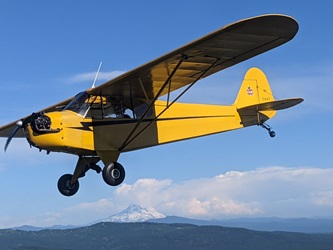
There is something about a Piper Cub. The nostalgia, the romance, the simplicity – and that iconic yellow paint. The Camas Washougal Flying Club in Washington State has been operating for 60 years, and all that time they have had the same airplane—a 1938 Piper Cub. The Aksarben Flying Club (which is Nebraska spelled backwards) recently formed with an airplane with a backwards sort of a name—a Citabria (Airbatic). We’ll take a look at both clubs and compare operating a Cub and Citabria in flying club.
Camas Washougal Flying Club
The Camas Washougal Flying Club is based at Grove Field (1W1) just east of Vancouver, WA. The club was founded in the fall of 1962 and a few months later acquired a 1938 Piper J-3 Cub. “The airplane entered service with the club in June 1963,” President Matthew Biges said. The club has been flying the plane ever since. Locally they are known simply as the “Cub Club.”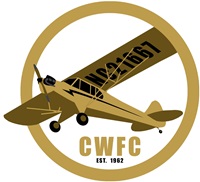
The club just celebrated its 60th anniversary, which is a story in itself. A few years ago the club went through a major transition. Matthew termed it “a generational shift.” The club was still operating as it had for decades. To book the plane, you wrote your name on a chalk board at the back of a dirt floor hangar. The Cub wasn’t flying much, in part because it could take 30 minutes or more to hand prop the plane to get it started. Just four years ago the club was charging $9 an hour for the aircraft, dry and dues were only $20 a month, which wasn’t sustainable.
The time had come for some major investments into the aircraft and the older generation that had been caring for the plane and flying it for decades basically stepped back and passed the baton to a group of newer members, many of whom are airline pilots. They needed to bring the club into the 21st century. The club did an extensive analysis of costs and updated the bylaws. They began using Flight Circle as their online scheduler, and increased dues to $50 a month and an hourly rate of $26, Tach time dry. The joining fee is now $2,000.Conversations were had on whether the club wanted to invest in the Cub, which has 11,000 hours, or sell it and get another J-3. Because of the plane’s legacy with the Camas Washougal Flying Club, the decision was made to keep the plane and make the investments needed. Working closely with the Vintage Flying Service, which specializes in restoring Stearman and other vintage aircraft, the club has made some major repairs. That included a new wing, overhauling the landing gear, and possibly the most noticeable improvement —a new carburetor and primer system so it now starts on the first pull. Matt hopes the club will be flying the plane well past it’s 100th birthday in 2038.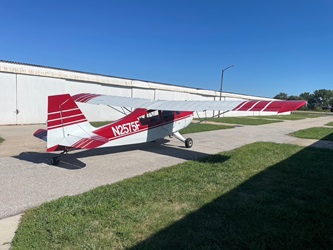
Aksarben Flying Club
“Aksarben was an accident, an unintended flying club,” Secretary Dave Ott said. He’s an airline pilot who had been out of general aviation for a long time. About three years ago he joined the Skyhawk Flying club based at Millard Airport (MIL). The club was founded in 1967, has 45 members and three aircraft—a Cessna 172K, a Piper Arrow III, and an A-36 Bonanza.
Dave was interested in getting a tailwheel endorsement but was having trouble finding an instructor and an airplane. “Through the AOPA Flying Club finder I found a small flying club that’s really low key down in Plattsmouth, Nebraska called Grassroots,” he said. They operate a 1946 Aeronca Champ but they didn’t have any openings. The club also requires members to have a tailwheel endorsement before joining. They referred Dave to an instructor, and he earned his endorsement. A membership opened and he joined the club. Soon after, the treasurer was approached by someone he knew who had a 1965 Citabria for sale and he thought the Grassroots Flying Club might be interested. The members couldn’t get consensus around selling the Champ to buy the Citabria, so Frank, the treasurer, approached Dave and another member and suggested they buy the Citabria and start a new club. Because Grassroots had a waiting list, they felt the area could support another club around the Citabria. In September 2022, Aksarben officially became a club. It has four members and they hope to grow to 10 members. The buy in is $5,000, and monthly dues are $30.
Operating Costs
Cub
Nearly 20,000 Piper Cubs were built between 1938 and 1947, making the J-3 one of the most popular planes of its time. Many are still flying today and can be purchased for anywhere between $35,000 to $70,000. With engines ranging from the original 65-hp Continental to 85 or 90-hp engines, a Cub will burn about 5 gph, making it one of the most economical aircraft to fly.
Camas Washougal charges $26 an hour, Tach time dry. Where else are you going to fly any airplane that economically?Citabria
The Citabria is a derivative of the Aeronca Champ and was first produced in 1964 by Champion Aircraft Corporation. Through various ownership changes, such as Bellanca and now American Champion Aircraft Corporation, the simple, well-liked designed has continued on with additional variations being produced such as the Decathlon and Scout. Among the differences are engine size, with variations from 115 hp to 180 hp, and whether the wing spar is metal or wood.
Early models through the 1970s can be purchased starting around $35,000 with prices increasing to about $95,000 for a newer model produced after 2000. Like the Cub, the Citabria sips gas at about 6 gph. The Club’s 7ECA has a 100-hp O-200, which is the smallest available engine on this model. Most Citabrias have a 150-hp engine but compared with the J-3’s 65-hp Continental, it’s seems powerful. Aksarben charges $67.05 an hour, tach time, wet and adjust the rate monthly based on fuel costs.
Maintenance
Cub
One of the beautiful things about older, simpler aircraft is maintenance tends to be easier because there are fewer things that can break or need servicing. With no electrical system, no starter, no avionics, and just a handful of basic instruments, a typical annual for a Cub runs between $700 and $900 each year, depending on maintenance shop rates. Parts are easy to find because there were so many Cubs built, Piper made several variations of the design over the years, and there is a plethora of modern Cub copycats.
Of course, any tube and fabric airplane will need to be recovered every 20 years or so, depending on the type of fabric on the aircraft, the climate the plane is in, and how much it has been exposed to the elements.However, with any older plane, there will be a time when major repairs are necessary. Camas Washougal has learned this firsthand, having replaced a wing and several cylinders.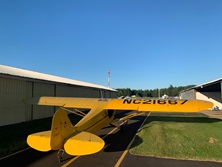
Finding a good mechanic that has tube and fabric experience and expertise in vintage aircraft is important—whether the club has a Cub or a Citabria. It could be a little more challenging to find a vintage aircraft mechanic than it is to find someone who works on 172s or Cherokees.
Citabria
Annuals tend to be inexpensive because there is less to look at. Aksarben did an annual when they did the pre-buy inspection. Dave said a basic annual with no repairs takes about 5.5 hours and costs about $500. Their mechanic charges $85 an hour.
Long-term, you have to plan for fabric recovery and fabric repair. Depending on how much exposure it has to the sun, it will need to be replaced generally about every 25 to 30 years. Since it is a tube and fabric airplane, it’s best to keep it in a hangar. The Citabria has an AD requiring an inspection of the wooden spar to check for cracks. It’s done either every 500 hours or annually, whichever comes first, Dave said. There’s also a lot of wood in the Citabria, like under the seats that needs to be inspected, and there can be rusty tubes in the tail. Dave also said the struts are somewhat unique for servicing. “It doesn’t have the spring-type gear you see on most 7ECAs,” he said. “It’s called a long-stroke, no-bounce strut—its patented name. It’s essentially an oleo with a spring. There’s nothing crazy to it, just make sure the fluid level is filled right.”
Insurability
Cub
Camas Washougal has been flying its Cub for 60 years, so it hasn’t had any trouble getting insurance for the aircraft. During the first year of the recent transition in which new members were joining, the club got a policy through Avemco to allow training for tailwheel endorsements. The club no longer does training, so it has switched to a standard policy for clubs, which for a Cub is about $1,500.
Citabria
Aksarben is paying $1,600 a year for insurance through Avemco. The low rate is in part because there are only four members—lowest time tailwheel pilot has 30 hours. The club expects the rate to go up as they add members, but they aren’t sure by how much.
Training
Cub
“I didn’t realize how little I knew about flying until I flew a Cub,” Matthew said. “It wakes up your feet.” The J-3 trained a generation of aviators prior to and during WWII, and there are some flight schools that still use Cubs as primary trainers before transitioning to modern aircraft for radio work and navigation. Today a Cub is more likely to be used for tailwheel endorsements for those pilots who are looking to improve their stick and rudder skills.
Just because it’s not complex, doesn’t mean the plane can’t get away from you if you’re not careful. “Because the Cub is unforgiving, this is the most honest airplane you’ll ever fly,” Matthew said. “It will tell you when you’re not in the slot.”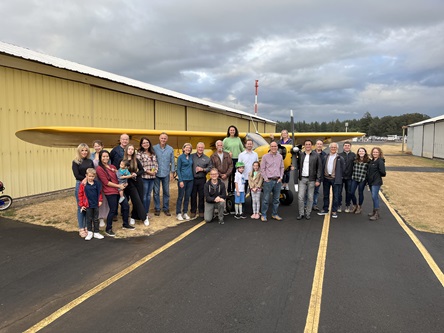
A Cub or Citabria will build your stick and rudder skills in a way a Cherokee or Cessna won’t. “In the flair you can’t see in front of you,” Matthew said. “You’ve got to trust your instincts. The Cub is an instinctual airplane.” Flying the Cub has made him a better airline pilot, he said. “If you can fly a Cub or a taildragger, you can fly any airplane.”
One drawback is the Cub doesn’t have a starter or electrical system. That means a pilot needs to be trained in safely hand propping the plane. Without an electrical system, there is no radio, which means you are limited to what airspace you fly in, or you’ll need a handheld radio.Citabria
Although Aksarben requires members to have a tailwheel endorsement to join, a Citabria is a good aircraft for tailwheel training. It is soloed from the front seat, so the visibility is much better than in a Cub, which is soloed from the rear seat. It also could be used for primary training but doing so would likely increase insurance rates.
One advantage the Citabria has over the Cub is that it has a starter, so no need to hand prop— it also has an electrical system with radios. Having either a Cub or a Citabria in a club provides an aircraft that can attract members who want to earn a tailwheel endorsement. The Citabria has the added benefit of possibly doing basic aerobatic training or upset recovery training. One of the challenges is finding instructors who can teach in it—whether it’s tailwheel or aerobatic, and if you are doing aerobatics, you’ll need parachutes that must be repacked regularly, which would add a cost. “I’m totally a disciple of tailwheel flying and a student too,” Dave said. “You’re learning as you teach. With each student you find a new gap of knowledge or an area to explore and improve upon and expand and solidify the skill set.”
Cross-Country
Cub
With only a 12-gallon header tank, cruising speed of 75 mph, and a useful load of 540 pounds, the Cub isn’t designed for long distance flights. “It’s like an old motorcycle – it’s uncomfortable. It’s noisy,” Matthew said. Despite that, he dreams of flying the Cub to Oshkosh with members driving in a van and taking turns flying the plane on different legs. The journey won’t be fast, but it will be an adventure.
Pilots with lots of Cub time always share stories of flying over a highway and cars passing them if there is even a slight headwind, and there are plenty of Cub pilots who have embarked on a low and slow odyssey across the United States and documented their adventures.
Citabria
The Citabria is a more capable cross-country aircraft than a Cub. It is faster, holds more fuel, and is more comfortable. “It’s a wider cabin than the J-3, so shoulder width is nice,” Dave said. But truth be told, it wouldn’t be most people’s first choice to take on a long trip.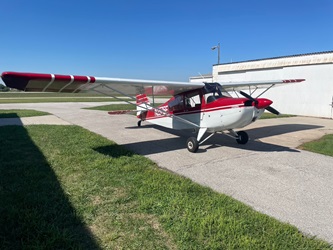
It has 35 usable gallons and with a fuel burn of about 6 gph, you could fly about five hours. Cruising at about 90 mph that’s about 400 to 450 mile range. One nice thing is with full fuel it has a useful load of 420 lbs. “It’s pretty remarkable to top off the tanks and still carry two normal sized humans,” Dave said. It also holds 100 lbs. in the luggage compartment.
Fun Factor
Cub
You really can’t fly in a Cub and not enjoy yourself. “It is the romance of flight,” Matthew said. “It is magical”—and that’s what attracts many of the members. There is a love of the old times flying from a bygone era. Some members like flying a plane with a stick rather than a yoke. Others enjoy the simplicity of it. It’s a plane that you fly low and slow and you can fly with the window and door open. “There’s nothing like taking someone flying and seeing them smile,” Matthew said.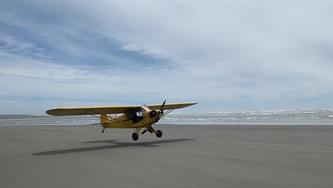
Citabria
The Citabria edges out the Cub in this category only because it is capable of doing aerobatics. “It’s not an aerobatic plane, it’s a plane that can do some aerobatics,” Dave said, before noting, “Its power to weight ratio is probably the same as a stock Stearman.”
Although the plane is rated +5/-2 Gs, the club does not plan to use it for aerobatics or upset recovery training for two reasons. First, the seats belts are standard three-point harnesses, and they don’t have parachutes. He also pointed out that, “One of our purposes is to provide enjoyment in aviation.”
Overall
You can’t go wrong with either a Cub or a Citabria. Both are inexpensive to operate and maintain, and a lot of fun to fly. It all comes down to what whether you are a romantic who harkens back to the early days of aviation or want something a little more modern, with a little more power, and a little edge.
All tailwheels have a higher baseline of a fun factor, period. The Citabria is a plane that you can fly low and slow like a J-3 Cub and follow rivers and fly over the countryside. But it’s also a plane that you can go cross county and do aerobatics. “It doesn’t do any of those things extraordinarily well, especially aerobatics, but you’re legal to do aerobatics and you can do what a J-3 does otherwise” Dave said. “I would argue that the bang for your buck is the fun.”If your club wants to offer something different yet cost effective, a J-3 Cub or Citabria are good choices. They can help attract members who want to earn a tailwheel endorsement and if you get a Citabria, members who want to do some aerobatic flying. Both are great airplanes to keep stick and rudder skills sharp, they’re cost effective to operate, and likely to become a club favorite.
Factsheet
|
Name |
Camas Washougal Flying Club |
|
Location |
Grove Field (1W1) Camas, WA |
|
Website |
none |
|
|
none |
|
Contact |
|
|
Year formed |
September 1962 |
|
Aircraft |
1938 Piper J-3 ($26/hr) Rates are Tach time, dry. |
|
Joining fee |
$2,000 Share buy in ($500 is refundable upon leaving in good standing) |
|
Monthly dues |
$50 per month |
|
Membership |
20 |
|
Scheduler |
Factsheet
|
Name |
Aksarben Flying Club |
|
Location |
Blair Executive Airport (BTA) Blair, NE |
|
Website |
none |
|
|
none |
|
Contact |
[email protected] or (402) 517-8001 |
|
Year formed |
September 2022 |
|
Aircraft |
1965 Citabria ($67.05/hr) adjusted monthly for fuel prices Rates are Tach time, wet. |
|
Joining fee |
$5,000 Share buy in |
|
Monthly dues |
$30 per month |
|
Membership |
4 (capped at 10) |
|
Scheduler |